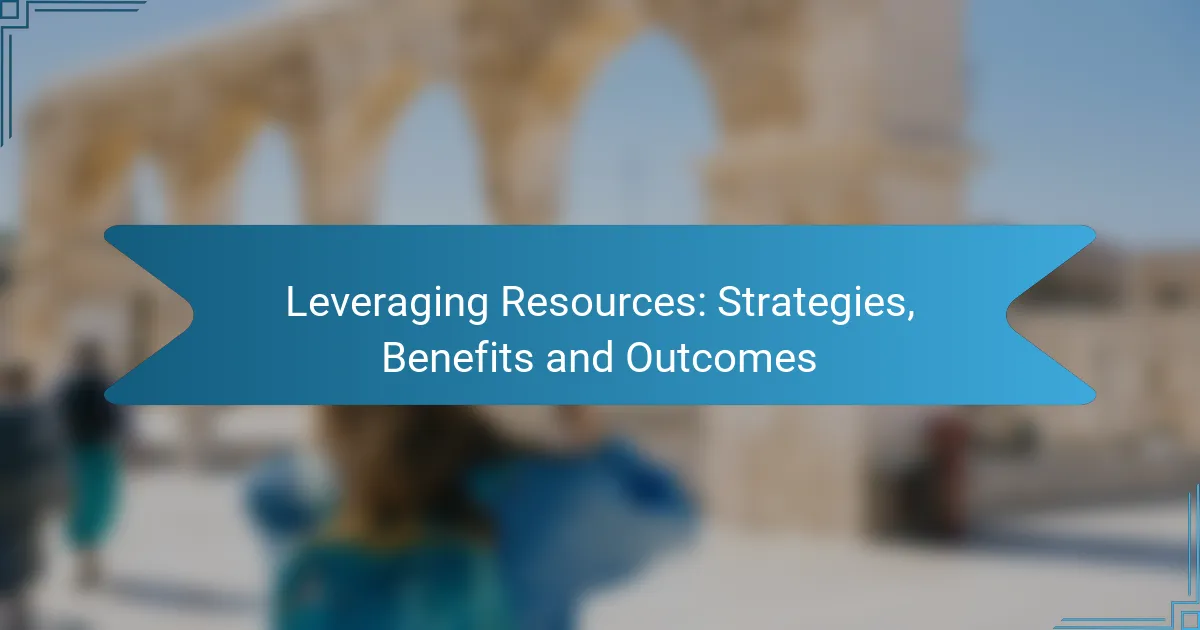Coalitions play a vital role in enhancing community efforts by bringing together diverse groups to collaborate, share resources, and amplify advocacy initiatives. By leveraging collective strengths, these alliances can address local issues more effectively and create a significant impact. Access to government grants, nonprofit partnerships, and online platforms further empowers coalitions to strengthen their initiatives and measure their success in meaningful ways.

How Do Coalitions Strengthen Community Efforts?
Coalitions enhance community efforts by fostering collaboration among diverse groups, pooling resources, and amplifying advocacy initiatives. This collective approach leads to more effective problem-solving and greater impact on local issues.
Enhanced collaboration
Coalitions promote enhanced collaboration by bringing together various stakeholders, including non-profits, government agencies, and community members. This teamwork allows for the sharing of ideas and strategies, which can lead to innovative solutions for local challenges.
For instance, a coalition focused on public health might unite hospitals, schools, and local businesses to address issues like obesity or substance abuse. By working together, these entities can create comprehensive programs that are more effective than isolated efforts.
Resource sharing
Resource sharing is a key benefit of coalitions, as it allows members to leverage each other’s assets, whether financial, human, or informational. This can significantly reduce costs and increase the reach of community initiatives.
For example, a coalition might share access to grant funding, training programs, or volunteer networks. This collaboration can help smaller organizations that may lack the resources to implement large-scale projects on their own.
Increased advocacy
Coalitions can amplify advocacy efforts by uniting voices around common goals, making it easier to influence policy and public opinion. A larger, coordinated effort often attracts more attention from decision-makers and the media.
When a coalition advocates for environmental protection, for instance, it can combine the efforts of local activists, scientists, and business leaders to present a united front. This collective advocacy can lead to more substantial changes in local regulations or funding for sustainability initiatives.

What Resources Are Available for Coalitions in the UK?
Coalitions in the UK can access various resources to strengthen their efforts and enhance their impact. These resources include government grants, nonprofit partnerships, and online platforms that provide essential support and tools for collaboration.
Government grants
Government grants are a vital resource for coalitions seeking financial support for their initiatives. These grants can come from local, regional, or national government bodies and are often aimed at specific projects or sectors, such as community development or environmental sustainability.
To apply for government grants, coalitions should research available funding opportunities through official government websites or funding databases. It’s crucial to carefully follow application guidelines and deadlines to increase the chances of securing funding.
Nonprofit partnerships
Partnering with established nonprofits can significantly enhance a coalition’s capacity and reach. Nonprofits often have experience, resources, and networks that can complement the coalition’s goals and initiatives.
When forming partnerships, coalitions should look for organizations with aligned missions and values. Establishing clear roles and responsibilities, as well as open lines of communication, can help ensure a successful collaboration.
Online platforms
Online platforms provide coalitions with tools for communication, collaboration, and resource sharing. These platforms can range from project management software to social media groups, facilitating engagement among coalition members and stakeholders.
Utilizing online platforms effectively requires selecting the right tools that fit the coalition’s needs. Considerations should include user-friendliness, accessibility, and the ability to integrate with other systems. Regular training and updates can help maintain engagement and maximize the benefits of these digital resources.

How Do Coalitions Measure Their Impact?
Coalitions measure their impact through various methods that assess effectiveness, engagement, and outcomes. These methods help coalitions understand their contributions and identify areas for improvement.
Performance metrics
Performance metrics are quantifiable measures that coalitions use to evaluate their success. Common metrics include the number of initiatives launched, participants engaged, and resources mobilized. For example, a coalition might track the percentage increase in community participation over a year.
When selecting performance metrics, it is crucial to align them with the coalition’s goals. This ensures that the data collected is relevant and actionable, allowing for informed decision-making.
Community feedback
Community feedback provides qualitative insights into the coalition’s impact. Surveys, focus groups, and interviews can gather opinions from stakeholders about the coalition’s effectiveness and areas for improvement. This feedback can reveal perceptions of the coalition’s initiatives and their relevance to community needs.
To effectively gather community feedback, coalitions should ensure anonymity and encourage honest responses. Regularly soliciting feedback helps maintain trust and engagement within the community.
Data analysis
Data analysis involves examining collected data to draw conclusions about the coalition’s impact. This process can include statistical analysis of performance metrics and thematic analysis of community feedback. By analyzing this data, coalitions can identify trends, successes, and challenges.
Coalitions should utilize data visualization tools to present findings clearly. This can help stakeholders understand the coalition’s impact and support strategic planning for future initiatives.

What Are the Key Challenges Faced by Coalitions?
Coalitions often encounter several significant challenges that can hinder their effectiveness and impact. Key issues include funding limitations, member engagement, and coordination problems, each of which requires strategic attention to overcome.
Funding limitations
Funding limitations are a primary challenge for many coalitions, affecting their ability to implement initiatives and sustain operations. Many coalitions rely on grants, donations, and membership fees, which can fluctuate significantly based on economic conditions and donor priorities.
To address funding limitations, coalitions should diversify their funding sources. This may include seeking partnerships with businesses, applying for government grants, or launching fundraising campaigns. Establishing a clear budget and financial plan can also help manage resources effectively.
Member engagement
Member engagement is crucial for the success of coalitions, as active participation drives collaboration and innovation. However, maintaining high levels of engagement can be challenging, especially if members have competing priorities or lack clear incentives to participate.
To enhance member engagement, coalitions should establish regular communication channels and provide opportunities for members to contribute meaningfully. Offering training sessions, networking events, and recognition programs can motivate members to stay involved and committed to the coalition’s goals.
Coordination issues
Coordination issues often arise in coalitions due to the diverse interests and objectives of member organizations. Effective collaboration requires clear communication and a shared understanding of goals, which can be difficult to achieve.
To mitigate coordination challenges, coalitions should implement structured meeting schedules and utilize project management tools to track progress. Establishing a central point of contact or a dedicated coordinator can also streamline communication and ensure that all members are aligned with the coalition’s objectives.

What Criteria Should Be Considered When Forming a Coalition?
When forming a coalition, it’s crucial to consider shared goals, diverse membership, and clear communication. These criteria help ensure that the coalition operates effectively and achieves its intended impact.
Shared goals
Establishing shared goals is fundamental for any coalition. All members should agree on the coalition’s primary objectives, which align with their individual missions. This alignment fosters unity and motivates members to work collaboratively towards common outcomes.
To define shared goals, engage all stakeholders in discussions to identify overlapping interests. Use techniques like brainstorming sessions or surveys to gather input and refine the coalition’s objectives. Aim for goals that are specific, measurable, achievable, relevant, and time-bound (SMART).
Diverse membership
Diverse membership enriches a coalition by bringing various perspectives, skills, and resources. Including members from different sectors, backgrounds, and expertise can enhance creativity and problem-solving capabilities. This diversity can also improve the coalition’s credibility and reach.
When forming a coalition, consider including representatives from government, non-profits, businesses, and community groups. Aim for a balance in demographics, such as age, gender, and cultural backgrounds, to ensure a wide range of viewpoints and experiences are represented.
Clear communication
Clear communication is essential for maintaining cohesion and transparency within a coalition. Establishing effective communication channels helps ensure that all members are informed, engaged, and able to contribute meaningfully. Regular updates and open dialogue can prevent misunderstandings and build trust.
Utilize various communication tools, such as emails, newsletters, and meetings, to keep members connected. Set clear expectations for communication frequency and formats to ensure everyone is on the same page. Encourage feedback and create a culture where members feel comfortable sharing their thoughts and concerns.



